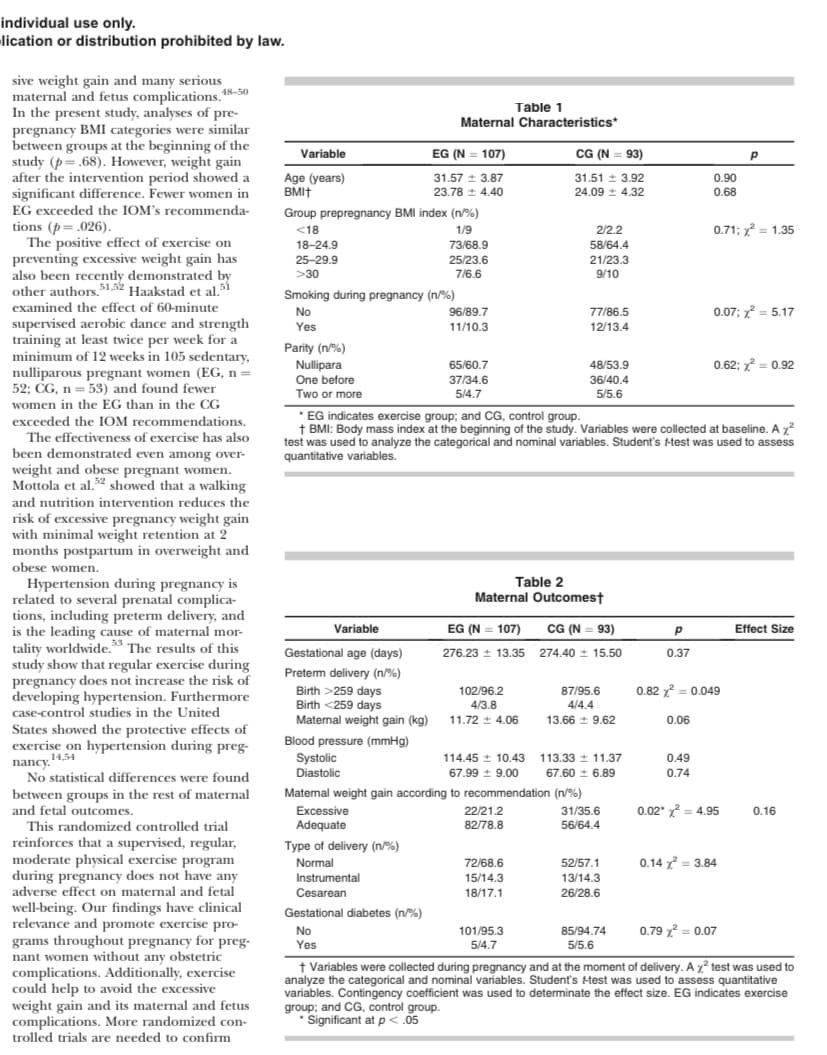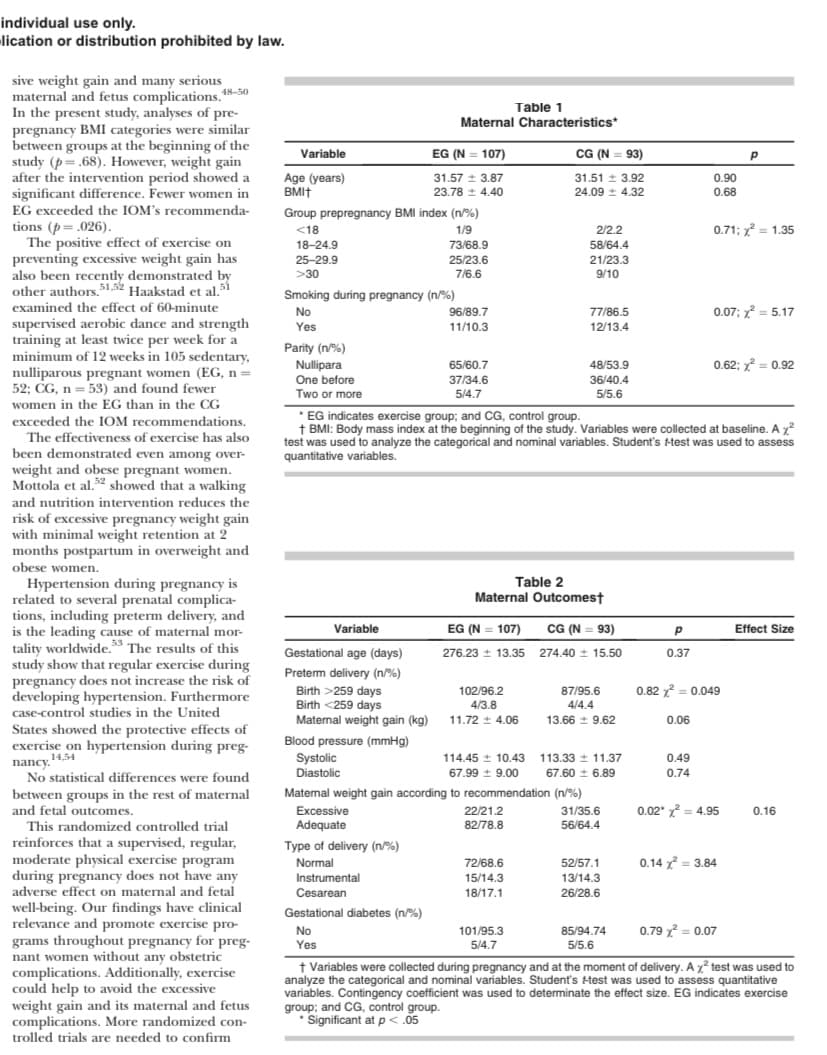1). What measures are used in statistical significance? 2). What were the measures used in statistical significance used in this study?
1). What measures are used in statistical significance? 2). What were the measures used in statistical significance used in this study?
Glencoe Algebra 1, Student Edition, 9780079039897, 0079039898, 2018
18th Edition
ISBN:9780079039897
Author:Carter
Publisher:Carter
Chapter10: Statistics
Section10.6: Summarizing Categorical Data
Problem 30PPS
Related questions
Topic Video
Question
1). What measures are used in statistical significance?
2). What were the measures used in statistical significance used in this study?

Transcribed Image Text:upervised aerobic dance and strength
individual use only.
lication or distribution prohibited by law.
sive weight gain and many serious
maternal and fetus complications, 48-30
In the present study, analyses of pre-
Table 1
Maternal Characteristics*
pregnancy BMI categories were similar
between groups at the beginning of the
study (p= .68). However, weight gain
after the intervention period showed a
significant difference. Fewer women in
EG exceeded the IOM's recommenda-
tions (p= .026).
The positive effect of exercise on
preventing excessive weight gain has
also been recently demonstrated by
other authors.1.52 Haakstad et al.1
EG (N = 107)
CG (N = 93)
Variable
Age (years)
BMIT
31.57 + 3.87
31.51 + 3.92
0.90
23.78 + 4.40
24.09 + 4.32
0.68
Group prepregnancy BMI index (n/%)
<18
1/9
2/2.2
0.71; = 1.35
18-24.9
73/68.9
58/64.4
25/23.6
7/6.6
25-29.9
21/23.3
>30
9/10
Smoking during pregnancy (n/%)
examined the effect of 60-minute
0.07: = 5.17
96/89.7
11/10.3
77/86.5
12/13.4
No
%3D
supervised aerobic dance and strength
training at least twice per week for a
minimum of 12 weeks in 105 sedentary,
nulliparous pregnant women (EG, n =
52; CG, n = 53) and found fewer
Yes
Parity (n/%)
Nullipara
0.62; x = 0.92
65/60.7
37/34.6
5/4.7
48/53.9
36/40.4
5/5.6
One before
Two or more
women in the EG than in the CG
* EG indicates exercise group; and CG, control group.
† BMI: Body mass index at the beginning of the study. Variables were collected at baseline. A x?
test was used to analyze the categorical and nominal variables. Student's test was used to assess
quantitative variables.
exceeded the IOM recommendations.
The effectiveness of exercise has also
been demonstrated even among over-
weight and obese pregnant women.
Mottola et al.52 showed that a walking
and nutrition intervention reduces the
risk of excessive pregnancy weight gain
with minimal weight retention at 2
months postpartum in overweight and
obese women.
Hypertension during pregnancy is
related to several prenatal complica-
tions, including preterm delivery, and
Table 2
Maternal Outcomest
uding
EG (N = 107)
CG (N = 93)
is the leading cause of maternal mor-
tality worldwide.3 The results of this
Variable
Effect Size
Gestational age (days)
276.23 + 13.35 274.40 ± 15.50
0.37
study show that regular exercise during
pregnancy does not increase the risk of
developing hypertension. Furthermore
case-control studies in the United
States showed the protective effects of
Preterm delivery (n/%)
Birth >259 days
Birth <259 days
Maternal weight gain (kg) 11.72 + 4.06
102/96.2
87/95.6
0.82 y = 0.049
4/3.8
4/4.4
13.66 ± 9.62
0.06
Blood pressure (mmHg)
exercise on hypertension during preg-
14,54
nancy."
Systolic
Diastolic
114.45 + 10.43 113.33 + 11.37
0.49
No statistical differences were found
67.99 + 9.00
67.60 + 6.89
0.74
between groups in the rest of maternal
and fetal outcomes.
Maternal weight gain according to recommendation (n/%)
Excessive
22/21.2
31/35.6
0.02' = 4.95
0.16
This randomized controlled trial
Adequate
82/78.8
56/64.4
reinforces that a supervised, regular,
moderate physical exercise program
during pregnancy does not have any
adverse effect on maternal and fetal
well-being. Our findings have clinical
relevance and promote exercise pro-
grams throughout pregnancy for preg-
nant women without any obstetric
Type of delivery (n/%)
Normal
0.14 x = 3.84
52/57.1
13/14.3
26/28.6
72/68.6
15/14.3
18/17.1
Instrumental
Cesarean
Gestational diabetes (n/%)
0.79 x = 0.07
101/95.3
5/4.7
No
85/94.74
Yes
5/5.6
complications. Additionally, exercise
could help to avoid the excessive
weight gain and its maternal and fetus
complications. More randomized con-
trolled trials are needed to confirm
t Variables were collected during pregnancy and at the moment of delivery. A x test was used to
analyze the categorical and nominal variables. Student's test was used to assess quantitative
variables. Contingency coefficient was used to determinate the effect size. EG indicates exercise
group; and CG, control group.
* Significant at p < .05

Transcribed Image Text:upervised aerobic dance and strength
individual use only.
lication or distribution prohibited by law.
sive weight gain and many serious
maternal and fetus complications, 48-30
In the present study, analyses of pre-
Table 1
Maternal Characteristics*
pregnancy BMI categories were similar
between groups at the beginning of the
study (p= .68). However, weight gain
after the intervention period showed a
significant difference. Fewer women in
EG exceeded the IOM's recommenda-
tions (p= .026).
The positive effect of exercise on
preventing excessive weight gain has
also been recently demonstrated by
other authors.1.52 Haakstad et al.1
EG (N = 107)
CG (N = 93)
Variable
Age (years)
BMIT
31.57 + 3.87
31.51 + 3.92
0.90
23.78 + 4.40
24.09 + 4.32
0.68
Group prepregnancy BMI index (n/%)
<18
1/9
2/2.2
0.71; = 1.35
18-24.9
73/68.9
58/64.4
25/23.6
7/6.6
25-29.9
21/23.3
>30
9/10
Smoking during pregnancy (n/%)
examined the effect of 60-minute
0.07: = 5.17
96/89.7
11/10.3
77/86.5
12/13.4
No
%3D
supervised aerobic dance and strength
training at least twice per week for a
minimum of 12 weeks in 105 sedentary,
nulliparous pregnant women (EG, n =
52; CG, n = 53) and found fewer
Yes
Parity (n/%)
Nullipara
0.62; x = 0.92
65/60.7
37/34.6
5/4.7
48/53.9
36/40.4
5/5.6
One before
Two or more
women in the EG than in the CG
* EG indicates exercise group; and CG, control group.
† BMI: Body mass index at the beginning of the study. Variables were collected at baseline. A x?
test was used to analyze the categorical and nominal variables. Student's test was used to assess
quantitative variables.
exceeded the IOM recommendations.
The effectiveness of exercise has also
been demonstrated even among over-
weight and obese pregnant women.
Mottola et al.52 showed that a walking
and nutrition intervention reduces the
risk of excessive pregnancy weight gain
with minimal weight retention at 2
months postpartum in overweight and
obese women.
Hypertension during pregnancy is
related to several prenatal complica-
tions, including preterm delivery, and
Table 2
Maternal Outcomest
uding
EG (N = 107)
CG (N = 93)
is the leading cause of maternal mor-
tality worldwide.3 The results of this
Variable
Effect Size
Gestational age (days)
276.23 + 13.35 274.40 ± 15.50
0.37
study show that regular exercise during
pregnancy does not increase the risk of
developing hypertension. Furthermore
case-control studies in the United
States showed the protective effects of
Preterm delivery (n/%)
Birth >259 days
Birth <259 days
Maternal weight gain (kg) 11.72 + 4.06
102/96.2
87/95.6
0.82 y = 0.049
4/3.8
4/4.4
13.66 ± 9.62
0.06
Blood pressure (mmHg)
exercise on hypertension during preg-
14,54
nancy."
Systolic
Diastolic
114.45 + 10.43 113.33 + 11.37
0.49
No statistical differences were found
67.99 + 9.00
67.60 + 6.89
0.74
between groups in the rest of maternal
and fetal outcomes.
Maternal weight gain according to recommendation (n/%)
Excessive
22/21.2
31/35.6
0.02' = 4.95
0.16
This randomized controlled trial
Adequate
82/78.8
56/64.4
reinforces that a supervised, regular,
moderate physical exercise program
during pregnancy does not have any
adverse effect on maternal and fetal
well-being. Our findings have clinical
relevance and promote exercise pro-
grams throughout pregnancy for preg-
nant women without any obstetric
Type of delivery (n/%)
Normal
0.14 x = 3.84
52/57.1
13/14.3
26/28.6
72/68.6
15/14.3
18/17.1
Instrumental
Cesarean
Gestational diabetes (n/%)
0.79 x = 0.07
101/95.3
5/4.7
No
85/94.74
Yes
5/5.6
complications. Additionally, exercise
could help to avoid the excessive
weight gain and its maternal and fetus
complications. More randomized con-
trolled trials are needed to confirm
t Variables were collected during pregnancy and at the moment of delivery. A x test was used to
analyze the categorical and nominal variables. Student's test was used to assess quantitative
variables. Contingency coefficient was used to determinate the effect size. EG indicates exercise
group; and CG, control group.
* Significant at p < .05
Expert Solution
This question has been solved!
Explore an expertly crafted, step-by-step solution for a thorough understanding of key concepts.
Step by step
Solved in 3 steps

Knowledge Booster
Learn more about
Need a deep-dive on the concept behind this application? Look no further. Learn more about this topic, statistics and related others by exploring similar questions and additional content below.Recommended textbooks for you

Glencoe Algebra 1, Student Edition, 9780079039897…
Algebra
ISBN:
9780079039897
Author:
Carter
Publisher:
McGraw Hill

College Algebra (MindTap Course List)
Algebra
ISBN:
9781305652231
Author:
R. David Gustafson, Jeff Hughes
Publisher:
Cengage Learning

Glencoe Algebra 1, Student Edition, 9780079039897…
Algebra
ISBN:
9780079039897
Author:
Carter
Publisher:
McGraw Hill

College Algebra (MindTap Course List)
Algebra
ISBN:
9781305652231
Author:
R. David Gustafson, Jeff Hughes
Publisher:
Cengage Learning